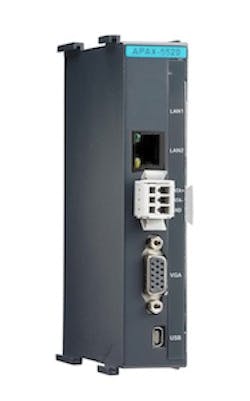Dual Controller PAC
They integrate the robustness of PLCs with advanced information, networking and programming features inherited from the personal computer (PC) world.The new Apax-5000 series from the Industrial Automation Group of Advantech includes an architecture with dual controllers with separate human-machine interface (HMI) and SoftLogic tasks. Designed to improve robustness the new PAC features two standalone CPU modules working together yet each responsible for different tasks. One provides computing power for HMI/SCADA, recipe, database and communication tasks while the other is dedicated for SoftLogic I/O tasks.This means if the HMI/SCADA controller crashes, the I/O processing won't be affected and will work as normal. Engineers can simply check the HMI/SCADA controller and maintain it without having to worry about the I/O processing tasks.Aside from the dual controller architecture, the APAX-5000 controllers also support backup functions. The same I/O processing program can be stored on two controllers, one will execute the I/O processing and if that controller fails, the second controller will automatically take responsibility for I/O processing within 1.5 seconds. Users don't need to write programs for this mechanism.Modules are well equipped to be either local I/O or remote I/O through their Ethernet bus backplane. The PAC offers one and two slot backplanes. Each backplane offers one expansion port. Using a standard Ethernet cable to connect the expansion port on the two backplanes, a remote expansion with local-bus speed is built with a distance up to 100 m. In addition, any standard Ethernet switch can be used between the two backplanes. The implementation of Ethernet switches not only enhances the flexibility of I/O expansion, it also increases the expansion distance. For example, if there are three Ethernet switches between two I/O stations, the expansion distance can be at least 400 m. (When fiber optic ports are available on the Ethernet switch, the distance can be much longer.) Modules may also be hot-swapped.

